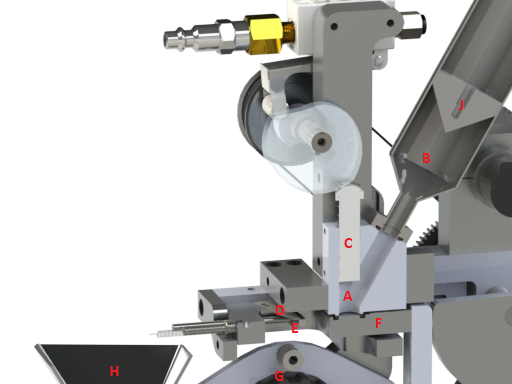
[Robert McMullen] designed and built this fascinating, fully automated, pyrotechnic star pump (Google cache). It was made as a project requirement for his engineering program — The inspiration? He also happens to be a member of the Olin College Fire Arts club.
Let’s backtrack for a second. What is a pyrotechnic star any ways? They are the pyrotechnic pellets that make up the heart of all projectile type fireworks. Usually either a metal dust, compound or salt, they are what makes the pretty colours and “stars” of the fireworks. Only problem? If they aren’t made right they can be rather dangerous. Luckily, [Robert] chose one of the safest methods: pumping. The basic concept is that the star mixture is damp as it is pressed into a cylindrical shape, and then cut and dispensed, ready for use after a drying period.
The machine is a very slick mechanical contraption that is even a bit mesmerizing to watch. There’s lots of info on his blog, and even the technical drawings and Solidworks files are available! If this all seems rather familiar, [Robert] built a similar machine that creates waterproof fuses.
Stick around after the break to see it in action! Unfortunately we regret to inform you… blowing up of the stars is not included.














I bet all the big fireworks manufacturers have watched this video, or will be very soon.
I really doubt it, not to be an ass. You can’t make layered stars with this machine, and making a giant patty and cutting it into “squares” is probably even more efficient. Source: worked in the industry for a while.
Not to mention you probably shouldn’t use friction sensitive composistions or anything with metal power or flakes that will destroy the machine.
Pumping stars is great for hobbyists who need a few hundred, but production factories have way faster methods of producing stars in quantity. They roll them in big vats that looks like cement mixers – here’s an example from Japan. http://youtu.be/_dINxkFcmc0?t=2m23s
My god, its full of stars…
oops! website down call a medic!!
My understanding is that the professional fireworks manufacturers don’t use any electricity in the huts where they make everything. So the compressed air is fine, but the 5V may not be a good idea.
My experience is solely from watching a few documentaries on the subject, so I’d hardly call myself an expert.
5V won’t spark (with enough energy) but all of this moving metal might be a concern, although I have seen manufacturers using cement mixers.
One thing to note is that pumped stars are only one of types that are used and not all effects can be done using them – for more sophisticated effects (strobe, crackling etc.) you need rolled spherical farms with multiple layers.
I can’t read the site now, but looking at the video I get the feeling that he has some problems with stars sticking to each other, resulting in poor uniformity and burn times.
Just a bit of nitpicking, because why not. 5V is plenty to produce sparks. Have a look at this little “toy” running at 3V http://youtu.be/GCrqLlz8Ee0
It’s less about the volts and more about the Amps. Such as the video you linked is 800 Amps where this machine is probably more like 12 Amps.
Actually, sparking is about voltage. A spark occurs when the voltage (potential) between two points is great enough to exceed the dielectric strength of air.
Cool! I’m thinking extruding the star mixture horizontally out of a nozzle directly onto a conveyor belt and then having a contraption that slices the star sausage into bits could be more efficient. But hell I’m not an engineer so what do I know :)
in the future you may want to host it on a site that does not have low limits or host it from your home connection.
you may need to change the listen port to other than 80 because many isps block 80 to prevent servers on home connection.
And another side killed by HaD!
honestly… if i had a project hosted by HAD and my site went down because of it(if i had my own site) that would be one of the coolest most exciting moments of my life. he probably has had more views because of this one article than the entire rest of his site’s history. well… maybe not including the other article too.